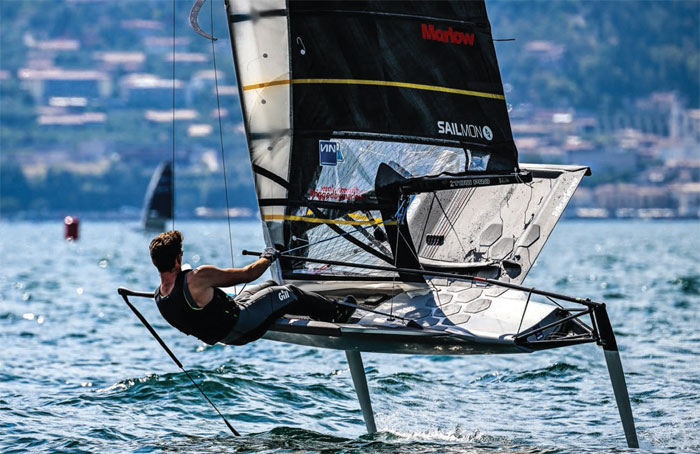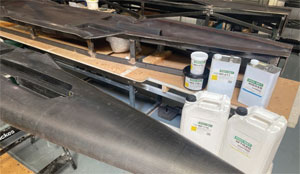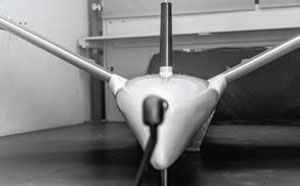

Not forgetting that the old one was pretty good!
There is plenty to shout about in the racing world, particularly for those who are involved at the cutting edge. Pro-Set has a long list of clients that are right in the thick of it, building boats from the blisteringly quick to the jaw droppingly beautiful. Among them is Maguire Boats, a small builder in a niche market based on the UK’s south coast that has enjoyed an impressive run of success and has played a huge part in shaping the high-performance world.
The company is famous for its International Moths, in particular its Exocet. In almost 10 years it has built 170 boats and won pretty much everything in the Moth world. But many believe that the influence of the Exocet was down to far more than simply straight line and argue instead that it redefined this popular foiling class while raising the bar among the fleet. And a look at their route to success over the last decade makes it easy to see why.
To dominate any development class, let alone such a vibrant and innovative one is impressive, but to do so for almost eight years is nothing short of extraordinary. But nothing lasts forever and as other builders and designers caught up and the performance gap started to close, Maguire Boats knew they needed to create the next generation of Moth. A reappraisal of what would make the next boat faster was required but they also knew that the success of the Exocet hadn’t just been about speed. Tapping into the recipe that had made them successful so far was going to provide an important focus.
‘We’ve been foiling for around 13 years now and our story started when we designed and built a couple of Moths that attracted the attention of a Gosport-based designer, Kevin Ellway,’ says company founder Simon Maguire. ‘Out of that came the Exocet. A number of features made the design quite radical when it came out, one was the hull shape.
‘Until then, hulls were quite square in section. At the time it was felt that because the boats would be on their foils most of the time there wasn’t much need to focus on hull shapes. But Ellway designed the Exocet with a more refined shape that would get to hull speed more quickly and therefore help the boat lift onto the foils earlier.
‘Then there was the configuration of the foils. Balancing the need for a large foil to promote early flight against the increase in drag at speed that would result from a bigger span foil was a tricky one to get right. There were plenty of other factors as well, but overall what became clear was that success would be about the entire package.’
Aside from straight line performance and handling, Maguire also believed that the goal for the Exocet was also to produce a boat that had good reliability, good after sales and good regatta support.
‘It won four world championships and numerous Europeans along with two or three national championships, so it took us to a point where we were selling boats worldwide and offering support and upgrades. It was this, as well as the speed of the Exocet that got us established in the Moth market,’ he continues.
‘After we won the 2019 World Championships with Tom Slingsby we sat down with Kevin to map out what would shape the next generation. We knew one of the big factors would be aero drag as the boats are now going so much faster. Typically we used to go upwind at 15-16kts, now we’re doing 20 and downwind the speeds are even higher. Apparent wind speeds are now around 35kts over the boat so with drag increasing exponentially against wind speed the need to focus on reducing it was clear.’
Determined that the next boat needed to be a significant step forward, but conscious that there was less open space to design in, their starting point was Slingsby’s Exocet from which they ran computer models for 30 different versions with a range of ideas from the refined to the radical. They used CFD (Computational Fluid Dynamics) software to analyse various components of the boat. This initial design process took almost a year. But once they had settled on an overall configuration it was time to build a couple of prototypes.

Above: the Aerocet’s defining features include low freeboard and ultra-thin foil struts with a very short chord, but the same bending and torsional properties as the Exocet’s foil struts. Fletcher won the 2022 Moth European Championship in Quiberon, France recently as well as Foiling Week.
‘P1 and P2 as we called them were based on a low windage, low freeboard configuration and were a big departure from the current Moth shape where the hull, rig, wings and the gantry were a more complete, integrated design. For example the hull morphs into the wings which work in a certain way that allow us to get more drive out of the rig.
‘We spent a year testing two prototypes where we were sailing around three or four times a week. After his Olympic 49er gold medal, Dylan Fletcher then came on board to help with the development.
‘The boat that has resulted from this development is the Aerocet and one of the distinctive features of this design is its low freeboard. In fact it looks quite striking from some angles but the interesting thing is that we’ve managed to maintain the volume by putting it in other places.’
It’s still early days for the Aerocet but the initial indications are good after a win at this year’s Foiling Week on Lake Garda. However, while the world’s top sailors help to drive development in the class and performance continues to increase, some are asking whether the Moth is becoming harder to sail as a result of its continual refinement.
‘It’s an interesting question,’ says Maguire. ‘The initial developments that we made with the Exocet actually made the boat easier to sail, for example getting onto the foils earlier certainly makes life easier. But it is also true to say that some of the upgrades that followed made the later Exocets harder to master. A deck-sweeping sail makes any boat more difficult to sail. On the other hand we’ve always worked very hard on creating the best control systems we can, which in turn means you can push the boat harder with confidence. So overall it’s not a straightforward answer.’
Below the waterline the development on the foils and the vertical strut have also been important areas. Roughly speaking, as speeds go up so the span of the foil can come down which reduces drag. And while there’s nothing new in this, it is clear that the ability to fly early also depends on what happens above the waterline.

Above and below: all resins, adhesives, additives and fillers for this challenging build are supplied by Pro-Set


Most recently Maguire has been working on the vertical strut which has a reduced chord and reduced thickness. This in turn has meant a focus on the structural aspects of the foil. ‘We spent a lot of time on this to create something that has the same structural characteristics as the original struts with the same bending and tortional properties. But again, the influences on this have changed. An increase in speeds means that what was once our small foil is now the standard foil because we’re going much faster. So now we need to develop an even smaller one.’
All of which points towards materials and highlights why Pro- Set’s involvement is so important. ‘Primarily in the foils we have been using resin infusion for which Pro-Set has provided a great deal of help to us. Foil struts are typically long and thin and have lots of unidirectional fibres in them so as a structure to infuse it’s about as hard as it gets.
‘Then on the hull side we use hand layup and vacuum bagging and here we use all Pro-Set products from infusion resins and adhesives to additives and filler powders.
‘Aside from the quality of their products the level of support that we get is superb and reflects our own objectives when it comes to supporting our customers, which in turn has been such an important part of our success to date.
‘The level of knowledge that Pro- Set makes available is already really impressive and on top of this they will also run test pieces as well, which is another way that they help us to feel confident about what we’re building. Part of the Exocet’s success is that it is such a reliable boat and having a strong relationship with your supplier is so important.
‘The other thing to bear in mind is that these boats clock up huge distances in their lives. During the testing of the prototype Fletcher racked up more than 7,500km. Durability and reliability is very important.’ When it comes to the cutting edge, success is clearly more than just about speed.
Click here for more information on Wessex Resins »
We invite you to read on and find out for yourself why Seahorse is the most highly-rated source in the world for anyone who is serious about their racing.
To read on simply SIGN up NOW
Take advantage of our very best subscription offer or order a single copy of this issue of Seahorse.
Online at:
www.seahorse.co.uk/shop and use the code TECH20
Or for iPad simply download the Seahorse App at the iTunes store


